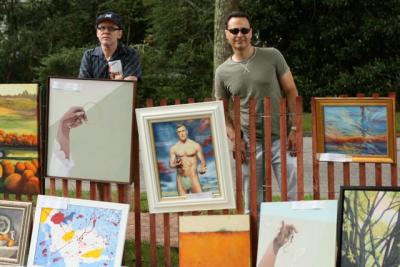The Art Scene: 08.01.13
The Art Scene: 08.01.13

Hanging Art to Dry
Guild Hall’s annual Clothesline Art Sale happens on Saturday, from 9 a.m. to 4 p.m. The annual event, which dates from 1946, features the work of nearly 400 artists and always attracts mobs of interested browsers and beginning collectors.
Prices range from $50 to $2,000, with all proceeds split evenly between the artist and Guild Hall. The event is free.
New at the Fireplace
The Fireplace Project in East Hampton will present its new group exhibition, “Reverse Engineering,” beginning Saturday with a reception from 6 to 8 p.m.
Organized by Bill Powers, it showcases the works of Aurel Schmidt, Josephine Meckseper, and Alisa Baremboym. The artists share a practice that prompts the viewer to ask “why” they might make an object, when they should ask “how,” according to Mr. Powers. “I’ve always been fascinated by the idea of reverse engineering and the associated fear that if a newfangled technology fell into the wrong hands, someone might deconstruct an object and spill all its secrets,” he said.
The exhibition will run from August 2 to 19.
Goldin at QF
The QF Gallery in East Hampton will present “Nan Goldin: Wish You Were Here,” an exhibition of photographs organized by Carrie Mackin. It will open on Saturday with a reception from 6 to 8 p.m.
Ms. Goldin’s photographs are known for their personal and confrontational images depicting friends, family, and lovers. Her work has been exhibited in major retrospectives internationally, among them the Whitney Museum and the Centre Pompidou in Paris. Her recent “Scopophilia” show was part of a program at the Louvre in 2011.
The exhibit will be on view through Aug. 18.
New Installations at LongHouse
Tomorrow, LongHouse Reserve in East Hampton will begin showing two of its new installations by the international artists Ai Weiwei and Yoan Capote.
Mr. Ai’s exhibition consists of gold animal and zodiac heads. Mr. Capote, a Cuban sculptor, will present a new compilation of works on paper in an exhibit called “The Other Nature of Things.”
The opening preview will take place from 5 to 7 p.m. and will include a concert on the lawn at 6, given by the Voxare Quartet, a young and innovative string quartet. Admission is $20, $10 for members. An off-site benefit dinner celebrating the exhibitions and concert costs $200; reservations can be made through the LongHouse office.
Through Aug. 17, at 8 on Saturday mornings, Jim Owen will hold sound meditation classes at LongHouse on the theme of transcendence. The classes will focus on helping students awaken “their own inner divinity,” according to a release. Admission is $20, $18 for members.
Twilight tours of the plantings and artwork on the grounds of the reserve are offered at 6 on Monday evenings, through Aug. 26. Tours are conducted by members of the LongHouse Garden Committee, and are limited to 15 people.
New York Dolls in East Hampton
The photo exhibit “New York Dolls” by Judy Mauer will be on display at the Lawrence Fine Art gallery in East Hampton from tomorrow through Sunday, with a reception and artist talk on Saturday at 5 p.m.
The photographs feature display-window mannequins while also capturing reflections of the city outside.
Grenning Shows Fenske
Ben Fenske will be the featured artist at Grenning Gallery in Sag Harbor from Saturday through Aug. 18. Mr. Fenske’s figurative paintings and a sculptural debut, “Wild Boar,” made with Richard Zinon, will be on view.
The artist first studied painting and drawing in Minneapolis with Peter Bougie and Joseph Paquet, before traveling to Italy to study at the Florence Academy of Art. He now works in New York and Italy.
There will be an opening reception at the gallery on Saturday, from 6:30 to 8 p.m.
Fischl on Friday
The Hampton Library will continue its Fridays at Five program this week with Eric Fischl.
Mr. Fischl, a resident of North Haven, is a figurative painter and sculptor with an international following and works in the collections of several major museums. He published an autobiography this year, “Bad Boy: My Life On and Off Canvas,” from which he will read tomorrow.
In a May review, The Star said that “what is different and effective in this book is that Mr. Fischl, who is as candid as can be about his own issues and hang-ups, lets others who played significant roles in his life have their say, even those whom he considered rivals, sometimes bitterly so.”
The library is at 2478 Main Street in Bridgehampton. Gates will open at 4:30 and beverages and hors d’oeuvres will be served in the rear garden. Admission is $15 per person.
Aycock Now at LongHouse, Too
Continuing her tour de force over the South Fork with exhibitions at the Parrish Art Museum this spring and currently at the Drawing Room, Alice Aycock’s new contemporary work, “Maelstrom,” is now on view at the LongHouse Reserve through Oct. 31.
“Maelstrom” is part of “Paper Chase,” an installation made up of six different works. “Paper Chase” will be exhibited on Park Avenue in Manhattan next spring. “Maelstrom” is a 30-foot-long aluminum sculpture, painted white. It will be expanded to 70 feet when shown in New York.
Canio’s Branches Out
Canio’s Cultural Cafe in Sag Harbor will begin its master artist studio series today with a visit to Whitney Hansen’s studio. The series will continue with James McMullan and Sheila Islam in coming weeks.
Each visit includes a tour and an opportunity to meet and speak with the artist. Ms. Hansen is known for her landscape paintings, created both in oils and the woodcut process of printing. Her work is in the collections of the Metropolitan Museum of Art and the Staten Island Museum. The studio will open at 4 p.m.
A single studio visit is $30, and a package price for all three is $75. Mr. McMullan’s tour is Aug. 15 and Ms. Isham’s is Sept. 5. An Oct. 5 afternoon fund-raiser at April Gornick’s studio will cost $125.
Stuart at Pierre’s
Pierre’s restaurant in Bridgehampton will present a photography show, opening on Saturday, of the work of Eve Stuart. The artist lives and works in New York City and East Hampton, and her work has been exhibited both there and here.
An opening reception will be held from 3 to 6 p.m. The photographs will be on display through Sept. 3.
Two New at Horowitz
“Tara Geer: Carrying Silence” will be the next show at Glenn Horowitz Bookseller in East Hampton, opening on Saturday with a reception from 6 to 8 p.m. Ms. Geer draws “large and kinetic charcoal universes, neither bodies nor landscapes, but microcosmic resolutions of form and psyche,” according to the gallery. What they look like are webs of cells and scaffolding, thumbprints, and scrawl or more figurative renderings. The show will be on view through Sept. 3.
On Monday, the photographs of the “Megumi Portfolio” in honor of Megumi Eda, a dancer who is also the subject of the images, will go on view. He is part of the Armitage Gone! dance company in New York, led by Karole Armitage, its director and choreographer. Ten artists worked with Mr. Eda in different styles and mediums: Chuck Close, Patrick Demarchelier, Eric Fischl, Bruce High Quality Foundation, Ralph Gibson, Nate Lowman, Mary Ellen Mark, Enoc Perez, David Salle, and William Wegman.
Armstrong Returns
Bill Armstrong will return to the Sara Nightingale gallery in Water Mill with “Buddha & Mandala,” opening on Saturday from 6 to 8 p.m.
Mr. Armstrong’s “Infinity” series, begun in 1977, consists of photographs of found images with the camera’s focusing ring set at infinity. According to the gallery, “the appropriated images are subjected to a series of manipulations — photocopying, cutting, painting, re-photographing — which transform the originals and provide new context.”
Since his first show in 2003, Mr. Armstrong has exhibited in a number of notable institutions, including the Smithsonian Institute. The show will run through Sept. 3.
Surfer DNA
Alberto Guglielmi will bring his “SurferDNA” exhibition to the Montauk Beach House, tomorrow through Aug. 14.
Mr. Guglielmi is a photographer and lifelong surfer. The exhibition aims to raise money for and awareness of the long-term struggles of Hurricane Sandy’s victims. He worked with artists, photographers, filmmakers, architects, and others to depict the subjects’ ties to the ocean with surfboard fins emerging from somewhere on their body. They include Cynthia Rowley, Richard Phillips, and many others.
Proceeds will go to Waves for Water’s Sandy Relief Intiative.
Popping Up in Montauk
Fabiola Beracasa and Art Production Fund, in association with Gary Carrion-Murayari and Joyce Sitterly of the New Museum, will present “Pop Up 1: Montauk.” The show features outdoor installations by Anya Kielar, Virginia Overton, and Olympia Scarry on view today through Sept. 8. on a vacant lot at 333 Old Montauk Highway.
The show will be open Thursday to Sunday from noon-6 p.m. A public opening reception for the artists will be held tonight from 6 to 8.

